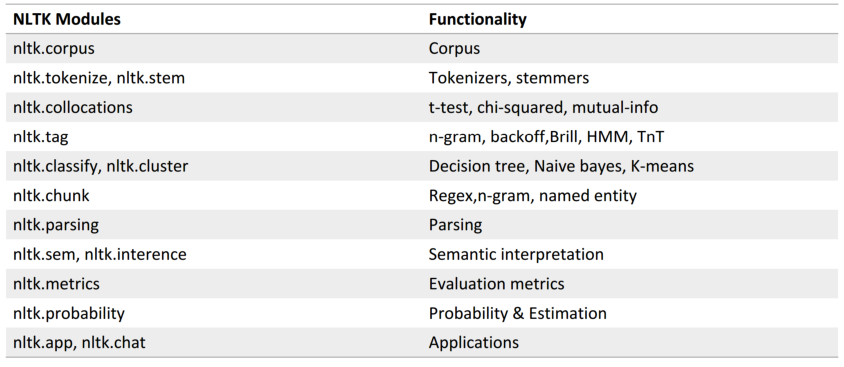NLTK与NLP原理及基础
参考https://blog.csdn.net/zxm1306192988/article/details/78896319
以NLTK为基础配合讲解自然语言处理的原理 http://www.nltk.org/
Python上著名的自然语⾔处理库
自带语料库,词性分类库
自带分类,分词,等功能
强⼤的社区⽀持
还有N多的简单版wrapper,如 TextBlob
NLTK安装(可能需要预先安装numpy)
pip install nltk
安装语料库
import nltk nltk.download()
NLTK自带语料库
>>> from nltk.corpus import brown >>> brown.categories() # 分类 ['adventure', 'belles_lettres', 'editorial', 'fiction', 'government', 'hobbies', 'humor', 'learned', 'lore', 'mystery', 'news', 'religion', 'reviews', 'romance', 'science_fiction'] >>> len(brown.sents()) # 一共句子数 57340 >>> len(brown.words()) # 一共单词数 1161192
文本处理流程:
文本 -> 预处理(分词、去停用词) -> 特征工程 -> 机器学习算法 -> 标签
分词(Tokenize)
把长句⼦拆成有“意义”的⼩部件
>>> import nltk >>> sentence = “hello, world" >>> tokens = nltk.word_tokenize(sentence) >>> tokens ['hello', ‘,', 'world']
中英文NLP区别:
英文直接使用空格分词,中文需要专门的方法进行分词
中文分词
import jieba
seg_list = jieba.cut('我来到北京清华大学', cut_all=True)
print('Full Mode:', '/'.join(seg_list)) # 全模式
seg_list = jieba.cut('我来到北京清华大学', cut_all=False)
print('Default Mode:', '/'.join(seg_list)) # 精确模式
seg_list = jieba.cut('他来到了网易杭研大厦') # 默认是精确模式
print('/'.join(seg_list))
seg_list = jieba.cut_for_search('小明硕士毕业于中国科学院计算所,后在日本京都大学深造') # 搜索引擎模式
print('搜索引擎模式:', '/'.join(seg_list))
seg_list = jieba.cut('小明硕士毕业于中国科学院计算所,后在日本京都大学深造', cut_all=True)
print('Full Mode:', '/'.join(seg_list))
纷繁复杂的词型
- Inflection 变化:walk=>walking=>walked 不影响词性
- derivation 引申:nation(noun)=>national(adjective)=>nationalize(verb) 影响词性
词形归一化
- Stemming 词干提取(词根还原):把不影响词性的inflection 的小尾巴砍掉 (使用词典,匹配最长词)
- walking 砍掉ing=>walk
- walked 砍掉ed=>walk
- Lemmatization 词形归一(词形还原):把各种类型的词的变形,都归一为一个形式(使用wordnet)
- went 归一 => go
- are 归一 => be
NLTK实现Stemming
词干提取:3种
1、
from nltk.stem.lancaster import LancasterStemmer
lancaster_stemmer=LancasterStemmer()
print(lancaster_stemmer.stem('maximum'))
print(lancaster_stemmer.stem('multiply'))
print(lancaster_stemmer.stem('provision'))
print(lancaster_stemmer.stem('went'))
print(lancaster_stemmer.stem('wenting'))
print(lancaster_stemmer.stem('walked'))
print(lancaster_stemmer.stem('national'))
2、
from nltk.stem.porter import PorterStemmer
porter_stemmer=PorterStemmer()
print(porter_stemmer.stem('maximum'))
print(porter_stemmer.stem('multiply'))
print(porter_stemmer.stem('provision'))
print(porter_stemmer.stem('went'))
print(porter_stemmer.stem('wenting'))
print(porter_stemmer.stem('walked'))
print(porter_stemmer.stem('national'))
3、
from nltk.stem import SnowballStemmer
snowball_stemmer=SnowballStemmer("english")
print(snowball_stemmer.stem('maximum'))
print(snowball_stemmer.stem('multiply'))
print(snowball_stemmer.stem('provision'))
print(snowball_stemmer.stem('went'))
print(snowball_stemmer.stem('wenting'))
print(snowball_stemmer.stem('walked'))
print(snowball_stemmer.stem('national'))
NLTK实现 Lemmatization(词形归一)
from nltk.stem import WordNetLemmatizer
wordnet_lemmatizer=WordNetLemmatizer()
print(wordnet_lemmatizer.lemmatize('dogs'))
print(wordnet_lemmatizer.lemmatize('churches'))
print(wordnet_lemmatizer.lemmatize('aardwolves'))
print(wordnet_lemmatizer.lemmatize('abaci'))
print(wordnet_lemmatizer.lemmatize('hardrock'))
问题:Went v.是go的过去式 n.英文名:温特
所以增加词性信息,可使NLTK更好的 Lemmatization
from nltk.stem import WordNetLemmatizer
wordnet_lemmatizer = WordNetLemmatizer()
# 没有POS Tag,默认是NN 名词
print(wordnet_lemmatizer.lemmatize('are'))
print(wordnet_lemmatizer.lemmatize('is'))
# 加上POS Tag
print(wordnet_lemmatizer.lemmatize('is', pos='v'))
print(wordnet_lemmatizer.lemmatize('are', pos='v'))
NLTK标注POS Tag
import nltk
text=nltk.word_tokenize('what does the beautiful fox say')
print(text)
print(nltk.pos_tag(text))
去停用词
import nltk
from nltk.corpus import stopwords
word_list=nltk.word_tokenize('what does the beautiful fox say')
print(word_list )
filter_words=[word for word in word_list if word not in stopwords.words('english')]
print(filter_words)
根据具体task决定,如果是文本查重、写作风格判断等,可能就不需要去除停止词
什么是自然语言处理?
自然语言——> 计算机数据
文本预处理让我们得到了什么?
NLTK在NLP上的经典应⽤(重点)
- 情感分析
- 文本相似度
- 文本分类
1、情感分析
最简单的方法:基于情感词典(sentiment dictionary)
类似于关键词打分机制
like 1
good 2
bad -2
terrible -3
比如:AFINN-111
http://www2.imm.dtu.dk/pubdb/views/publication_details.php?id=6010
import nltk
from nltk.corpus import stopwords
from nltk.stem import SnowballStemmer
snowball_stemmer = SnowballStemmer("english")
sentiment_dictionary = {}
for line in open('AFINN-111.txt'):
word, score = line.split('\t')
sentiment_dictionary[word] = int(score)
text = 'I went to Chicago yesterday, what a fucking day!'
word_list = nltk.word_tokenize(text) # 分词
words = [(snowball_stemmer.stem(word)) for word in word_list] # 词干提取,词形还原最好有词性,此处先不进行
words = [word for word in word_list if word not in stopwords.words('english')] # 去除停用词
print('预处理之后的词:', words)
total_score = sum(sentiment_dictionary.get(word, 0) for word in words)
print('该句子的情感得分:', total_score)
if total_score > 0:
print('积极')
elif total_score == 0:
print('中性')
else:
print('消极')
缺点:新词无法处理、依赖人工主观性、无法挖掘句子深层含义
配上ML的情感分析
from nltk.classify import NaiveBayesClassifier
# 随手造点训练集
s1 = 'this is a good book'
s2 = 'this is a awesome book'
s3 = 'this is a bad book'
s4 = 'this is a terrible book'
def preprocess(s):
dic = ['this', 'is', 'a', 'good', 'book', 'awesome', 'bad', 'terrible']
return {word: True if word in s else False for word in dic} # 返回句子的词袋向量表示
# 把训练集给做成标准形式
training_data = [[preprocess(s1), 'pos'],
[preprocess(s2), 'pos'],
[preprocess(s3), 'neg'],
[preprocess(s4), 'neg']]
# 喂给model吃
model = NaiveBayesClassifier.train(training_data)
# 打出结果
print(model.classify(preprocess('this is a terrible book')))
文本相似度
使用 Bag of Words 元素的频率表示文本特征
使用 余弦定理 判断向量相似度
import nltk
from nltk import FreqDist
corpus = 'this is my sentence ' \
'this is my life ' \
'this is the day'
# 根据需要做预处理:tokensize,stemming,lemma,stopwords 等
tokens = nltk.word_tokenize(corpus)
print(tokens)
# 用NLTK的FreqDist统计一下文字出现的频率
fdist = FreqDist(tokens)
# 类似于一个Dict,带上某个单词, 可以看到它在整个文章中出现的次数
print(fdist['is'])
# 把最常见的50个单词拿出来
standard_freq_vector = fdist.most_common(50)
size = len(standard_freq_vector)
print(standard_freq_vector)
# Func:按照出现频率大小,记录下每一个单词的位置
def position_lookup(v):
res = {}
counter = 0
for word in v:
res[word[0]] = counter
counter += 1
return res
# 把词典中每个单词的位置记录下来
standard_position_dict = position_lookup(standard_freq_vector)
print(standard_position_dict)
#新的句子
sentence='this is cool'
# 建立一个跟词典同样大小的向量
freq_vector=[0]*size
# 简单的预处理
tokens=nltk.word_tokenize(sentence)
# 对于新句子里的每个单词
for word in tokens:
try:
# 如果在词典里有,就在标准位置上加1
freq_vector[standard_position_dict[word]]+=1
except KeyError:
continue
print(freq_vector)
这里求的是一个词频率向量。
求完之后再运用上述那个公式。
应用:文本分类
TF-IDF是一个整体
TF:Term Frequency 衡量一个term 在文档中出现得有多频繁。
TF(t)=t出现在文档中的次数/文档中的term总数
IDF:Inverse Document Frequency ,衡量一个term有多重要。
有些词出现的很多,但明显不是很有用,如 ‘is’’the’ ‘and’ 之类的词。
IDF(t)=loge(文档总数/含有t的文档总数)
(如果一个词越常见,那么分母就越大,逆文档频率就越小越接近0。所以分母通常加1,是为了避免分母为0(即所有文档都不包含该词)。log表示对得到的值取对数。)
如果某个词比较少见,但是它在这篇文章中多次出现,那么它很可能就反映了这篇文章的特性,正是我们所需要的关键词。
TF−IDF=TF∗IDF
NLTK实现TF-IDF
from nltk.text import TextCollection
# 首先,把所有的文档放到TextCollection类中
# 这个类会自动帮你断句,做统计,做计算
corpus = TextCollection(['this is sentence one',
'this is sentence two',
' is sentence three'])
# 直接就能算出tfidf
# (term:一句话中的某个term,text:这句话)
print(corpus.tf_idf('this', 'this is sentence four'))
# 对于每个新句子
new_sentence='this is sentence five'
# 遍历一遍所有的vocabulary中的词:
standard_vocab=['this' 'is' 'sentence' 'one' 'two' 'five']
for word in standard_vocab:
print(corpus.tf_idf(word, new_sentence))
得到了 TF-IDF的向量表示后,用ML 模型就行分类即可:










 浙公网安备 33010602011771号
浙公网安备 33010602011771号